How to install the pump in the well
Laying communications is one of the most important problems for owners of country houses. The water supply issue is no exception. It is solved, as a rule, with the help of a well in which the pump is installed.
How to properly install the pump in the well and will be discussed in our article.
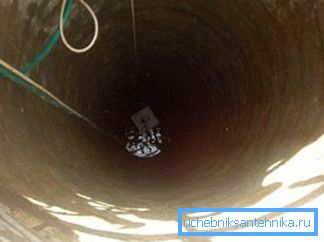
Types of pumps used
To begin, we will look at two main types of pumps that are used to lift water:
- Surface Devices - they are installed outside the well. They have an affordable price, but at the same time they are not able to pump water from a great depth. Therefore, they are rarely used in wells; (See also the article Surface pump for a well: device features.)

- Submersible devices - placed directly in the water. Unlike the previous species, they are able to reach the liquid from great depths. This explains their widespread use in wells. In addition, they are protected from overheating, as they are cooled by the water passing through them.
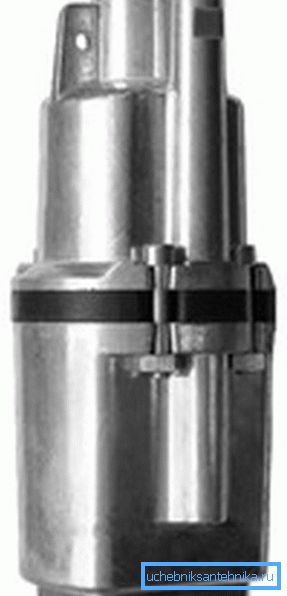
Tip! Get models equipped with a float switch. It automatically stops working if the water level is too low. This prevents the device from running dry and its subsequent failure.
Pump Installation Procedure

As already mentioned, the most popular are submersible pumps. Therefore, below we will talk about their installation.
Preparatory work
Installation of a well pump begins with the preparatory work. First of all, a recess is dug from the edge of the well to the wall of the house. Then a hole is made in the well wall at the level of the trench.
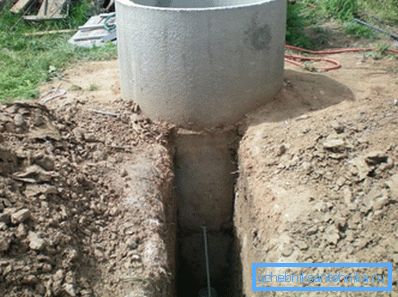
After this, the ditch is cleared of stones and other foreign objects. Further, a layer of sand 10 centimeters thick is poured in there. It will serve as a pillow on which the pipe will later be laid.
Then, take the sleeve and install it into the hole previously made. Its diameter should be slightly larger than the circumference of the pipe, and a length of 0.5 meters.
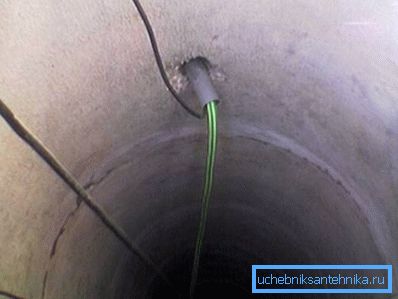
For the purposes of subsequent installation, a polyethylene pipe is purchased, as well as fittings, couplings and a connecting bend. For cutting PVC pipes will require special scissors. If not, they can be replaced with a bench saw.
Tip! Make sure that the diameter of the pipe and all connecting elements coincide with the size of the output connector of the pump. Otherwise, connect the pipe will not work.
A few hours before installation, straighten the pipe. This will facilitate the installation process.
Pipe connection

Installation of the pump in the well continues by connecting the pipe. To do this, first determine the distance between the point of the intended placement of the pump and the hole in the wall of the well.
A tube is passed through the sleeve into the well, which is then re-displayed on the surface and unfolds on the ground along its entire length. A cable from the pump is placed along it.
If the pump is not equipped with a built-in check valve, then it should be attached and secure the coupling. Further, the chamfer is removed from the tube, after which it is attached to the device. Then, every 50 cm with electrical tape, an electrical cable is attached to the pipe.
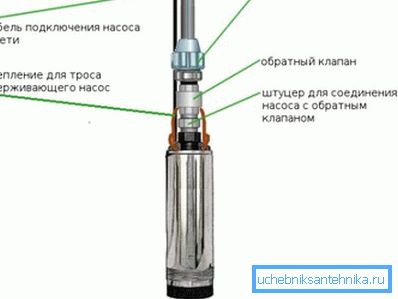
Pump mount
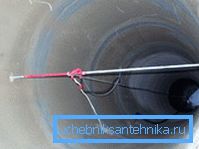
The installation of the submersible pump in the well is completed by its fastening. For this purpose, a cable is used, which is inserted into the lugs of the device and secured at the top of the well.
The pipe is insulated and insulated. Then the machine is lowered into the water.
Tip! The device, being inside the well, should not come into contact with its walls. This may cause damage to the product.
The cable is fixed in such a way that the whole mass of the suspended structure is held by him, and not by a pipe. Otherwise, damage will occur.
It is quite possible that you will not be able to make installation outside. In this case, to solve the problem of how to install the pump in the well, will have to be different, namely, to go down inside the well.
For descent down is used a ladder. It goes down to the required level, after which a bar is placed under one of the upper rails, which should rest on the edges of the well.
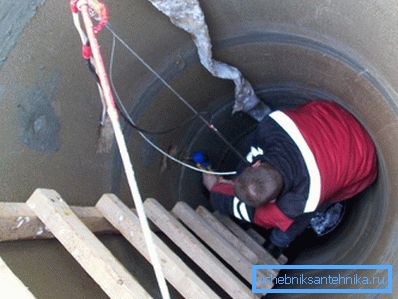
In order to secure, we use a solid rope, which should be tied at the level of the torso. After that, you can get to work. First of all, the pumping column is lowered. Then, with the help of the knee, it connects with the tube coming out of the sleeve.
Additional devices
Installation instructions for the pump would be incomplete without mentioning additional devices, the installation of which allows to get a complete pumping station as a result.
These include:
- Hydraulic storage tank - it is needed to maintain constant pressure in the water supply system. In addition, due to its use, it is not necessary to turn on the pump often. And in the event of a power outage, it will serve as an emergency source of water supply. The larger the volume of this tank, the better, although it is worth considering that the price of a product of a larger volume will be higher;
- Pressure switch - this device turns on the pump when the water level in the acoustical accumulator decreases below the minimum value. After reaching the top mark, the relay automatically shuts off the pump.
Conclusion
All pumps are divided into two types.
- superficial and
- submersible.
The most popular is the second type, which is installed deep in the well. Its installation begins with digging a trench and making a hole in the wall of the well.
Through this opening, the first section of pipe is passed to which the second section leading to the pump is connected with the help of the knee. The whole structure is suspended on a cable fixed at the top of the well bore.
We recommend to pay your attention to the video in this article. With it, you can learn more about how to install a submersible pump in the well.